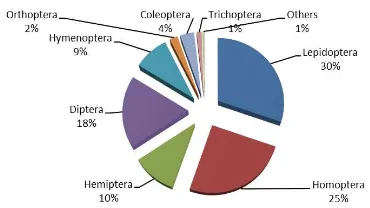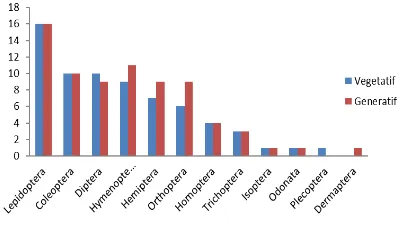Int. J. Trop. Vet. Biomed. Res. Vol. 3 (1) : 25-29; May 2018
www.jurnal.unsyiah.ac.id/IJTVBR
E-ISSN : 2503-4715
Composition And Biodiversity Of Insect Species In Wheat Cultivation In Gayo Highland
Muhammad Sayuthi1, Husni2, Lukman Hakim3, Hasnah4, Alfian Rusdy5, Tjut Chamzurni6,
and Firdaus7
1,2,3,4,5,6Study Program of Plant Protection, Agricultural Faculty, Syiah Kuala University,
7Student of Agrotechnology Study Program, Agricultural Faculty, Syiah Kuala University
Email for correspondence:[email protected]
Abstract
The need for wheat in Indonesia continues to increase and reaches 3.9 million tons per year. Around 80% of this requirement are supplied from, Canada, Australia and the United States. Gayo highland that belongs to the territory of Aceh province is potential for wheat plantation in Indonesia. Wheat plantation, however, faces various problems, one of them is pest attack. Various insect species come to wheat plantation and are predicted to get food sources both from vegetative and generative stages. The objectives of this study were to investigate composition and diversity of insect species in wheat plant either in vegetative or generative stages by adopting survey method. The results showed that total insects found in wheat plants were 2,858 individuals covering 13 ordos. Occurrence and diversity of the insects, either in vegetative and generative stages, tend to similar.
Keywords composition, diversity, insect, wheat, vegetative stage, generative stage
Background
Wheat (Triticum aestivum L.), which originally comes from Turkey, Siria, Iraq, supplied from Turkey, Canada, Australia and he United States of America Serikat and used as raw material for bread, biscuit, noodle industries as well as a variety of home needs. The need for wheat flour in Indonesia continuously increases to 10% nationally in 2015. Aceh province, especially Bener Meriah Regency, becomes one of areas potential for wheat cultivation in Indonesia due to its appropriate environment for wheat plants (Welirang 2011).
In Indonesia, Gayo highland (Aceh) has been stated as optimum location for wheat cultivation since 2008. Other provinces in Indonesia categorized effective
areas for wheat cultivation are North Sumatra, West Sumatra, Jambi, Bengkulu, South Sumatra, Lampung, West Java, Central Java, East Java, West Nusa Tenggara, East Nusa Tenggara, East Borneo and South Celebes (Doni, 2012).
both in vegetative and generative stages in Gayo highland region.
Materials and Methods Study Aim
This study was carried out to investigate composition and diversity of insects associated with wheat plant both in Village of Timang Gajah Subdistrict, Bener Meriah Regency from March – June 2015.
Equipments and Materials
Equipments used in this study were microscope, film bottle, label paper, scissors, camera, meteran, plastic bag, rubber gelang, baskom, book and writing generative stage of wheat plant.
Study Implementation 1. Insect Collection
Insect collection was done by using a light trap set in the afternoon from 6 pm – 8
reference book for insect determination (Siregar, 2007). cultivation during vegetative and generative stages.
4. Composition of Insect community in the wheat plants according to ordo and species counted a formula used for counting diversity index of Shannom-Winner as the following:
Prediction of insect species biodiversity from wheat plant areas was done using the system of Jackknife Estimator. Species accumulation curve was created by counting all insect species collected from each sample block randomized 18 times using EstimateS
program version 8.20 (Schoowalter,2000). Diversity and homogeneity indexes were quantified Primer program version 5.
Results and Discussion
1. Total Insects found in wheat plantation during vegetative stage From totally 13 ordoes of insects found in the vegetative stage of wheat plants Lepidoptera was the most prevalent ordo,
followed by Homoptera, Diptera,
Coleoptera, and Orthoptera) compared to those may act as natural enemies that is around 11% (Isoptera, Dermaptera, Neuroptera, and Odonata). This condition might cause pest outbreaks due to less numbers of natural enemy in the sorghum plantation areas.
Figure 1. Percentage of individual insect from each ordo found in the vegetative stage of wheat plant
The most prevalent individual insect found was from the ordo lepidoptera (30%) compared to the native enemy ordo Hymenoptera (0.8%), and was not very effective to suppress the population of pest insect (Hasibuan 2013). According to Doni (2012) insect ordo usually destruct wheat plant in Indonesia come from the ordo Hemiptera, Lepidoptera, Homoptera, and Orthoptera. In addition to destruct the wheat plants, these pests could also destruct rice plants.
2. Total insects found in the wheat plantation during generative stage During generative stage, the numbers of individual insect commonly found in the wheat plantation were from ordo
Lepidoptera, Homoptera, Diptera,
Hemiptera, Hymenoptera, Orthoptera, and Coleoptera compared to from others ordo (Isoptera, Dermaptera, Neuroptera, and Odonata) (Figure 2).
Figure 2. The numbers of individual insect found in the wheat plantation during generative stage.
The percentage of insect ordo found in the generative phase of wheat plant were Lepidoptera (33%), Homoptera (23%),
Hemiptera (14%), Diptera (12%),
Hymenoptera (8%), Orthoptera (6%), Coleoptera (2%) and Tricoptera (2%). Individuals from the ordo Lepidoptera were found in the highest percentage (33%) and this probably related to the availability of feed sources and the less occurrence of the natural enemy Hymenoptera to effectively suppress the population of the pest insect, ordo Lepidoptera. Wheat plants that have gotten into generative phase were the most preferred by insects because of the availability of food sources. According to Hasibuan (2013), plants entered flowering phase (generative) were visited by many insect species, especially from ordo Lepidoptera, Hemiptera, Homoptera and Orthoptera
3. Density of individual insects collected from wheat plants
Figure 3. Individual insects found in the vegetative and generative phases
4. Composition of insect community in wheat plant
Results of observation on the composition of insect community based on species biodiversity of wheat plants showed that the majority insects found in the location from the ordo Lepidoptera, Col-eoptera, Diptera, Hymenoptera, Hemiptera, Orthoptera, and Homoptera whereas some other, with less proportion, belong to the ordo Isoptera, Dermaptera, Neuroptera, and Odonata (Figure 4).
Figure 4. Composition of insect community according to species biodiversity in the wheat plants during vegetative and generative phases
Data in Figure 5 showed that insect community occurred in the vegetative phase was generally dominated by those belong to Lepidoptera namely 16 species, followed by those belong to Coleoptera (15 species) and Diptera (15 species). Insects found in the
belong to ordo Lepidoptera (16 species), followed by those belong to ordo Hymenoptera (11 species) a Coleoptera (10 species). The numbers of individual insect belonged to ordo Diptera, ordo Hemiptera, ordo Orthoptera and ordo Homoptera found were 9, 9, 9, and 4 species, respectively.
Conclusion
Based on results of study performed it can be concluded that:
1. Total insects collected from wheat plant cultivation in Gayo highland were 2,858 individuals and belonged to 13 ordo and 83 species.
2. The most predominant insect found during vegetative and generative were from ordo Lepidoptera, Homoptera, Hemiptera, and Diptera.
3. The richness, biodiversity and homogeneity of insect species found in the wheat plant tended to similar during vegetative and generative phases.
References
Doni, H. 2012. Uji Adaptasi Beberapa Genotip Gandum (Triticum aestivum L.)
di Sukarami, Kabupaten Solok
[Adaptation test on wheat genotype
Triticum aestivum L. in Sukarami, Solok Regency]. Padang: Andalas University.
Hasibuan. 2013. Pengaruh Fase
Perkembangan Tanaman Padi Terhadap Keanekaragaman dan Kelimpahan Pop-ulasi Serangga Hama di Desa Ajee Rayeuk Kecamatan Ingin Jaya Kabupaten Aceh Besar [Effect of development phase of rice plant on the biodiversity and richness of pest insect populations in Ajee Rayeuk Village of Ingin Jaya Subdistrict, Aceh Besar Regency]. Undergraduate thesis. Banda Aceh: Faculty of Agriculture, Syiah Kuala University.
Tenrirawe dan Pabbage, 2010. Annual Report. Cereals Research Agency. (Accessed on March 7th, 2013).

